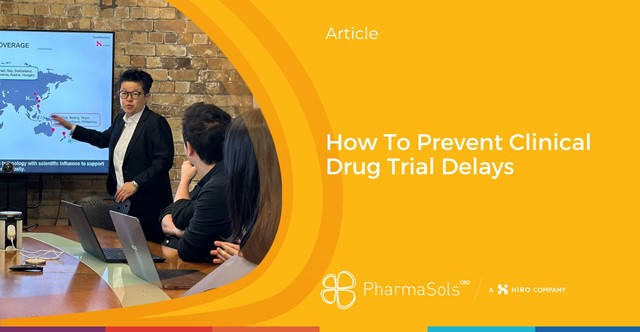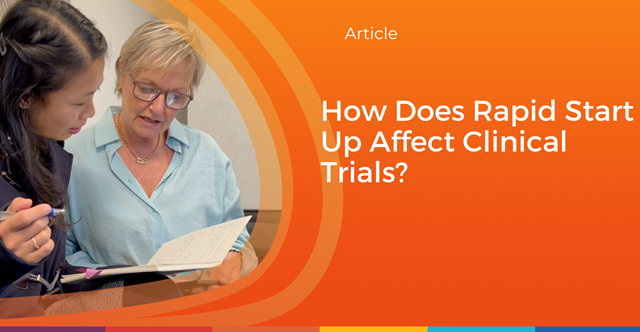13 Jul
The Key to Increasing Patient Retention in Clinical Trials

With 85% of clinical trials experiencing delays [1], any opportunity to keep a trial on track can save a study money, time, and resources.
There are a lot of reasons a trial can be derailed, with poor patient retention being among one of the biggest struggles.
It is natural for some patients to drop out, as study participation is voluntary. However, identifying the common reasons for participant drop out helps sponsors to address these issues to increase the patient retention rate.
Why do patients drop out?
The first thing to address is: why do patients drop out in the first place?
Some common reasons for participant drop out include:
- Location of the site
- Scheduling conflicts
- Personal reasons
- Lack of effective communication from the PI
- Fear and anxiety
- Unmet expectations
Some of these are out of a sponsor’s control, and any trial should be prepared to deal with a certain amount of dropouts that may simply come down to a participant changing their mind . However, sponsors can minimise reasons such as fear and anxiety by establishing effective communication, clear expectations, and accessible location of the site prior to the recruitment process.
Patient Centricity
Patient recruitment outcomes are driven right from the start of the trial. This means that developing a patient centric protocol design is essential for recruitment and retention.
A patient centric trial is centred around the voice and the needs of the patient, making the study attractive and easy for participants.
Proactively engaging with patients is one the most important aspects of a patient centric trial. With scheduling conflicts being one of the most common reasons participants drop out, accommodating for their lifestyle while scheduling appointments should be an important consideration. Some examples of how this can be incorporated include scheduling appointments for working patients over the weekends while booking earlier appointments for the older patients.
There won’t be one ideal time for everyone, so it’s also essential for sponsors to allow for flexibility. This has become evident in the COVID-19 world as the development of telehealth, and virtual trial technologies has benefited those unable to travel while also assisting participants who struggle with getting to trial sites.
Since the pandemic began, participants have become warier of travel and participating in clinical trials for fear of exposure to the virus. Virtual trials minimise this fear and anxiety by eliminating the threat of COVID-19 transmission through in-face trial site visits.
Selecting a site
Patient experience should be a priority during the site selection process of a clinical trial.
A survey found that 38% of patients who dropped out of a trial said it was because the site visits were ‘stressful’ [2]. Sites that have also adopted a patient centric attitude will likely be able to retain patients better than those who don’t.
Having a friendly, professional environment, clear communication, and even free parking can significantly impact patient retention.
Phillippa Murray of Lakeland Clinical Trials Group says, “We have found our new site location with onsite car parking has made an enormous difference to our patient visits. We have 100% attendance to onsite visits. Patients also comment on how available our investigators are to them, especially the Principal Investigator.”
Choosing your trial’s location
Where a clinical trial is run can also determine patient retention.
In Australia and New Zealand, there is a strong willingness to participate in clinical trials. Trial stats from ANZCTR show that between 2015 and 2020, patient recruitment exceeded expectations, resulting in 103% retention of patients [3]. This has been a combination of efforts put in by the Australia Government and a highly informed, willing, and ethically diverse patient population spread across both regions.
The relatively low transmission rates of COVID-19, particularly in New Zealand, means the population is not as fearful of contracting the virus and therefore more inclined to participate in studies.
Even with there being less risk to exposure to COVID-19 in New Zealand, telehealth capabilities and virtual trial technologies were adopted early into the pandemic and have been widely embraced in this region. Our remote monitoring SOPs take into consideration the safety of the sites, patients, and staff, while also ensuring the continuity of trials.
By establishing clear processes that directly address the needs of participants, sponsors are thereby showing their appreciation for patients' participation.
PharmaSols recognises the importance of building processes based on a patient centric attitude. Our people-driven team is dedicated to delivering participant recruitment and retention targets.
Sources:
[1] Facts about clinical trials. (Online) Available at: http://www.arena-international.com/clinicaltrials/facts-about-clinical-trials/1063.article (Accessed 07/07/2021)
[2] Retention in Clincial Trials: Keeping Patients on Protocols (Online) Available at: https://www.advarra.com/resource-library/retention-in-clinical-trials-keeping-patients-on-protocols/?swpmtx=ed651b04db65b0b1ef8e082dbbee1837&swpmtxnonce=e3e8a38eeb (Accessed on 07/07/2021)
[3] Australia New Zealand Clinical Trials Register (2015-2020) Commercial Trials
Other News
March 2024 (1)
February 2024 (1)
December 2023 (1)
November 2023 (1)
October 2023 (1)
September 2023 (2)
August 2023 (1)
July 2023 (1)
June 2023 (2)
May 2023 (3)
April 2023 (1)
March 2023 (2)
The Go-to region for clinical trials (1)
HiRO – our global advantage, tailored solutions and key partnerships (1) (1)
HiRO – an emerging full-service global CRO (1)
HiRO – Top CRO in APAC 2022 (1) (1)
November 2022 (1)
October 2022 (1)
September 2022 (1)
August 2022 (1)
July 2022 (1)
June 2022 (1)
May 2022 (1)
April 2022 (1)
March 2022 (1)
January 2022 (1)
December 2021 (1)
November 2021 (1)
October 2021 (2)
September 2021 (2)
August 2021 (3)
July 2021 (3)
June 2021 (2)
May 2021 (1)
April 2021 (2)
March 2021 (1)
February 2021 (1)
December 2020 (5)
November 2020 (1)
October 2020 (5)
September 2020 (1)
August 2020 (2)
May 2020 (5)
January 2024 (0)



